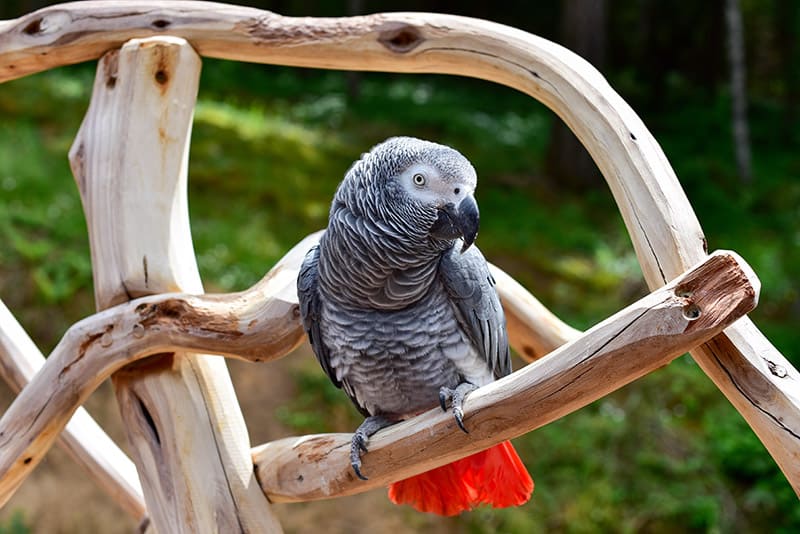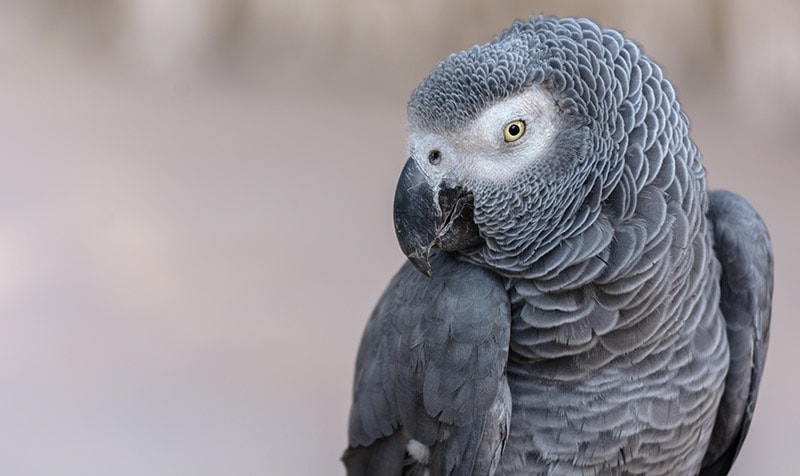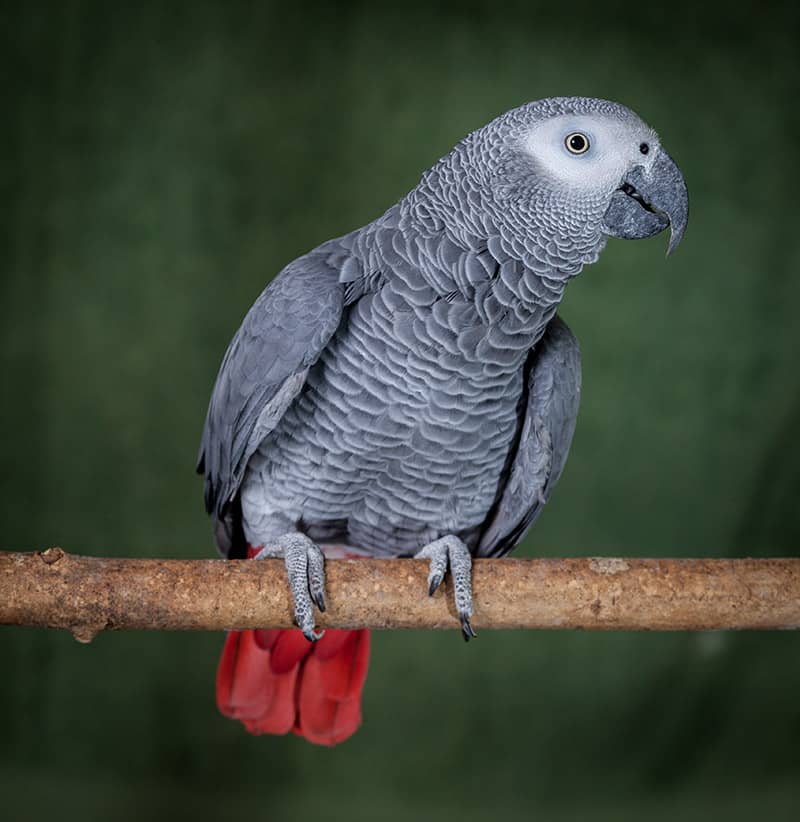African Grey Parrots are intelligent and charming,… and the best talkers of all the exotic birds!
The African Grey Parrot is one of the most popular pet birds with an amazing ability to talk. This fabulous bird is not only handsome, but is also an inquisitive, interactive and charming companion. Their personality and intuitive nature will amaze and delight you, and their antics will amuse you to no end. These are very intelligent social creatures, making them an excellent pet for a devoted parrot owner.
African Grey Parrots are sought out as a pet for their good looks and strong speaking ability. Yet talking is just one of the Grey Parrot’s learned skills, they are also great mimics of the sounds in their environment. They can distinguish and mimic the voices of individual people, as well as things like the other birds, the phone ringing, the microwave, and more. Although they can talk and mimic, they are neither overly noisy nor tend to engage in loud shrieking calls like some of the other vocal parrots.
With all these great qualities, African Greys are very favored parrots to keep as a pet, but these parrots do take a very committed keeper. They are highly intelligent so can quickly become bored if not provided with plenty of stimulation. They need continuous human interaction along with lots of safe, but destructible toys to manipulate.
Greys like being handled, but are also perfectly content to just be around the family. They have natural wild instincts still intact so must have supervision and care taken when interacting with people. They can be likened to the intellect of a 5 year old, but the emotions of a two year old. So they need strong socialization when young, and then ongoing training to be good members of your family.
The bird guides for each of the two common species, the Congo African Grey Parrot, and the Timneh African Grey, provide in-depth information about living with them and their activity needs, along with housing, care and feeding.
- For information on parrot care, see: Bird Care: How to Take Care of a Pet Bird
African Grey Parrots
African Grey Parrot Origin
The African Grey Parrots Psittacus erithacus are found in a broad area of Western and Central Africa, inhabiting both primary and secondary rainforests. African Greys usually reach maturity at about 4 or 5 years of age, and have a life span of about 50 (or more) years in captivity.
African Grey History
The keeping African Grey Parrots as pets is noted throughout history, probably back to biblical times. One early author of the latter part of the 1800’s, Dr. W. T. Greene, wrote several volumes on bird species including “The Grey Parrot and How to Treat It”, 1885. He believed this parrot was actually known to the ancient Hebrews some 4000 years ago. In early days the Grey Parrot was frequently called “Jaco” relating to the sound of their natural cry, possibly originating with Portuguese seafarers who kept their company on long sea voyages.
There are a number of literary citations and other examples of early keepings of this parrot as a pet. The wealthy nobility of Europe valued this pet for its attractiveness and speaking ability. In the early 1500’s it is said that King Henry VII of England had an African Grey Parrot at Hampton Court.
A well-known manuscript by the German naturalist, Johann Matthäus Bechstein, in his classic treatise on cage birds written in 1774, describes an African Grey owned by Cardinal Ascanius. This pet parrot could recite the Apostles’ Creed in an articulate and uninterrupted manner. The oldest surviving example of bird taxidermy is an African Grey Parrot that can be seen in the Westminster Abbey in London. It was the pet parrot of Frances Teresa Stuart, Duchess of Lennox, and it died in 1702, shortly after its mistress.

African Grey Types
There are only three distinct birds in this genus Psittacus erithacus, with the two most popular being the Congo African Grey Parrot and the Timneh African Grey. Whether or not these three birds are different species, subspecies or simply variants of the main species, Psittacus erithacus, is still an open debate.
Congo African Grey Parrot (Psittacus erithacus)
The Congo African Grey is the nominate species of this genus. It is found in the west-central part of Africa mainly within 10 degrees north and south of the equator. This parrot is also known as the Red Tailed Grey, and in aviculture its name is shortened to CAG.
The African Grey Congo is dark gray with a red patch of feathers on the underside of the tail. They vary between 13 – 16″ (32.5 – 40.6 cm) in length, from beak to tail, with a weight between 400 – 650 grams. Occasionally this bird can be seen with some red feathering throughout its body, and this variant is known as the Red Factor Grey.
Timneh African Grey Parrot (Psittacus erithacus timneh)
The Timneh African Grey Parrot naturally occurs in Liberia, Sierra Leone, and the western most parts of the Ivory Coast. It is known as TAG in aviculture.
The African Grey Timneh is darker gray than its Congo counterpart, and with a maroon tail and it has a pink color on the upper third of the upper mandible. The Timneh also differs from the Congo in its size, being noticeably smaller. The Timneh ranges between 11 – 13″ (27.5 – 32.5 cm) in length from beak to tail, with a weight between 275 – 400 grams.
Psittacus erithacus princeps
Another seldom seen African Grey Parrot, Psittacus e. princeps, can only be found on the islands of Principe and Gernando Po in the Gulf of Guinea. This bird is darker than the regular African Grey.
African Grey Mutations
As with most parrots, mutations occur naturally in the wild. Naturally occurring Grey mutations include:
- Albino (Blue Ino)- no pigment and are all white
- Incomplete Ino – with only very partial pigmentation
- Blue – white pigment in the tail
Very few of these naturally occurring Grey mutations have been bred successfully in captivity. In captivity, mutation is the result from altering the genes to adjust the melanin level, and to add other colors. Much work has been done in by breeders in South Africa, Australia, New Zealand, and Scandinavia to make mutations that are subcategories of the naturally occurring coloration.
The earliest Ino mutations date back to the 1800’s. One of the more recent developments was the first all Red African Grey. It was developed by in 1998 by Von van Antwerpen from South America and his New Zealand partner, Jaco Bosman. They developed this bird from selected F2 Pied mutations.
Grey mutations include:
- Red-pied – red flight feathers
- F2 Pied – broad red band across the abdomen
- Grizzles – soft pinkish scalloping found in its feathers
- Ino (Albino) – all white except for the tail, which is red
- Incomplete Ino – mostly white, but with a small amount of melanin giving them black / gray in the wings
- Ino Blue – no pigment
- Blue – white pigment in the tail
- Parino (or Pallid, Pastel) faded coloring overall
- Lutino – yellow pigment
- Cinnamon – brown instead of gray

African Grey Behavior
African Grey Parrots are highly intelligent, inquisitive, and love to interact with people and objects. Yet they have a long life span, it can be 50 years (or more) in captivity. Many of the available pets being are only a generation or two away from their wild counterparts. They still have their wild nature intact and can be unpredictable at times. Their many qualities that make them desirable pets also require a special commitment from their keepers of regular one-on-one interaction and on-going training.
The African Grey Parrots make very loyal and devoted companions, but they are not for everyone. Being a caretaker of an African Grey is not easy. They require lots of love, time, patience and effort to build a relationship. Being somewhat shy and cautious by nature, they are reserved with new people and objects. They tend to sit back and watch before giving of themselves freely. They are also are very intuitive to emotions, so are best approached in a calm manner. Once your Grey is comfortable and trusts you, you are on your way to a lifelong friendship.
An African Grey will need frequent interaction and playtime outside of their cage. Their cage needs to be large, and they need a lot of toys that are safe as well as destructible. They have a habitual nature and develop a strong bond with their family. They become comfortable with their space and human companions; changes in environment and people, or unfamiliar objects, can cause great stress. They can become nervous and fearful.
When Greys are not provided with a comfortable, known environment that is secure yet stimulating, they can become nervous and fearful. Unpleasant behavior and even health problems can develop. Such things as feather plucking and nipping are common undesirable results. Once established, these types of problems are difficult to remedy. It’s much better (and easier) to address the needs of your pets right from the start.
To have a well-adjusted African Grey, they should to be exposed to different situations and handling by different people while they are young. They require ongoing attention by their keepers and stimulating interaction with various types of toys. This will help them cope more successfully whenever changes occur, being less fearful and timid, and more social.
Parrot Talk – Intelligence
Experts regard the African Grey Parrot as one of the most intelligent birds, and in the class with the most intelligent animal species. Their talking has been determined to be a learned skill, and not mimicry. They have been found to speak in sentences, respond appropriately to questions, and can physically manipulate objects with a purpose.
They have been known to have vocabularies of well over 200 words. In one case a bird named “Prudle”, a male African Grey, is listed in the Guinness Book of World Records as having a vocabulary of over 1000 words. However, these parrots don’t usually start talking until they are about a year in age. Many can start earlier, many that don’t talk until about 2 years of ages or older, and some simply may not talk at all.
Research done by with captive African Grey Parrots by Dr. Irene Pepperberg of the Alex Foundation, has scientifically demonstrated these birds can associate words with objects, color, numbers, and more. She has been studying the intelligence and reasoning abilities for almost 30 years. Her most notable subject was the African Grey Parrot Alex, who died in 1977. More recent work is being carried on with two new African Grey additions, the parrots Arthur and Griffin. These parrots are classed along with the most intelligent animal species Experts now believe these parrot perform cognitive tasks at the same level as dolphins, chimpanzees, and even a toddler.
Featured Image by: Lilian Dibbern, Unsplash


